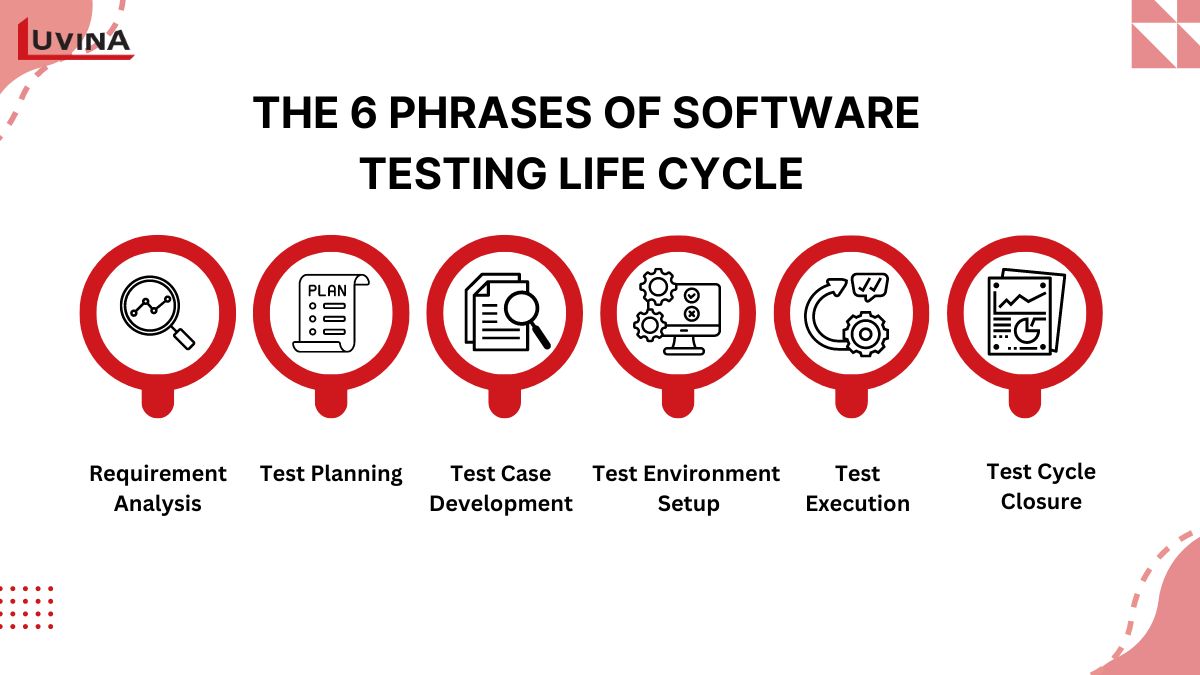The software testing life cycle (STLC) is an important process that helps ensure software meets standards. It is carried out systematically, in stages, and is often confused with the software development life cycle (SDCL). To better understand the STLC and distinguish it from the SDLC, read the following article.
What is the Software Testing Life Cycle (STLC)?
The software testing life cycle is an end-to-end testing process to ensure the software meets quality standards. The steps in this cycle are carried out systematically, through different stages, to check if the software meets specific requirements, has any bugs, etc. During software development, the stages of the QA testing process can be repeated until the software is deemed suitable for the customer.

The main goal of the software testing life cycle is to identify and record any errors or issues in the software as early as possible during development. This helps specialists make necessary changes and adjustments to resolve all problems before the software is released to the public.
Phases of Software Testing Life Cycle
The software testing life cycle includes 6 stages. Each stage has different input requirements and output criteria. Some of these stages can be carried out simultaneously, while others must be completed before moving on to the next stage.

1. Requirement Analysis
This is the first stage of the end-to-end testing process. In this stage, the feature requirements gathered during the software development process are evaluated to determine the aspects that need to be tested. In other words, the quality assurance team needs to understand the requirements and know what to test. If necessary, the testing team can consult with stakeholders to get a clearer understanding of the needs.
During the Requirement Analysis stage, the testing team needs to create a requirements traceability matrix to map requirements to test cases. The goal of this stage is to help the testing team understand the software requirements and identify any potential issues that could impact the software testing life cycle. If this stage is done well, the end-to-end testing process can focus on the most important aspects of the software, and the testing team can deliver high-quality results.
2. Test Planning
This is the most important and effective stage in the software testing life cycle, where all the test plans are determined. In this stage, the testing team needs to calculate the necessary efforts, estimate costs, list the required tools, and assign specific roles and responsibilities for the testing tasks. This stage begins right after the Requirement Analysis stage is completed.
3. Test case development
This is the stage of the software testing life cycle where the testing team must document all detailed test cases and prepare the necessary test data. The test cases should be clear, effective, and highly adaptable. This is also the stage where any necessary automation scripts are created.
By the end of this stage, the testing team should have a comprehensive and accurate set of test cases that provide full coverage for the software or application. This ensures that the testing process is thorough, identifies all potential issues, and resolves any bugs before the software is released.
4. Test Environment Setup
Setting up the test environment is a crucial stage in the SDLC life cycle in testing. The test environment determines the conditions under which the software is tested. In this stage, the test environment is configured and deployed, and the test servers are set up. This is an independent stage and can begin simultaneously with the test case development stage. The goal of this stage is to create a fully functional test environment and validate the test cases.
5. Test Execution
Stage 5 marks the beginning of test execution. In this stage, the testing team starts testing the features in the deployed environment using the established test cases. The test results are collected and reported to the development team. The goal of this stage in the testing process is to perform all necessary tests and document all results.
6. Test Cycle Closure
This is the final stage of the software testing life cycle. In this stage, all tests must be completed, and test results must be documented to compare expected outcomes with actual outcomes across various aspects such as achieved goals, execution time, cost, test coverage, and identified bugs. The goal of this stage is to ensure that the software is ready for release.
Benefits of Software Testing Life Cycle
The QA testing process is always a crucial procedure in any software development life cycle. This process brings several benefits to software development, such as:
- – Facilitating flexible, consistent, and efficient testing procedures.
- – Clearly defining project goals and expectations, ensuring all project requirements are met.

- – Accelerating the pace of the end-to-end testing process and enabling testing teams to detect and address issues swiftly.
- – Easier project progress tracking due to clearly defined goals and stages of SDLC in software testing.
- – Ensuring every feature is thoroughly tested and meets requirements before adding new features.
STLC vs SDLC: What Is the Difference?
The software development life cycle (SDLC) and software testing life cycle are interconnected phases of software development with overlapping timelines and distinct objectives. The complete journey of developing software from inception to product release is known as a software development life cycle.
Testing is a crucial stage within this cycle. In other words, the STLC is a part of the software development life cycle and focuses specifically on testing. The software development life cycle focuses on building a product based on user requirements to achieve the goal of deploying a high-quality product for users. On the other hand, the testing life cycle in software testing concentrates on testing a product to identify its errors, and reporting them so that the development team can promptly fix them, ensuring the software meets the specified requirements.
The end-to-end testing process can be conducted after completing the software development life cycle stages or simultaneously with its stages. To successfully execute both life cycles, collaboration among stakeholders, DevOps, and the testing team is essential. Without it, verifying requirements and ensuring the quality of test results can be challenging.
Software Testing Life Cycle Best Practices
To ensure a smooth software testing life cycle, here are some essential practices you shouldn’t overlook:
- Early and frequent testing: The earlier you test, the lower the chance of errors and the better your testing planning and design effectiveness. Instead of waiting until the final stages, conduct testing throughout the development process.
- Comprehensive test planning: Detailed test planning is crucial for project success. It should include clear goals, scope, schedule, resource requirements, and potential risks. A well-defined test plan forms the foundation for a smooth testing process.
- Test automation: Use appropriate automation tools to enhance test coverage and efficiency. Automation accelerates repetitive tasks, allowing testing teams to focus on more complex scenarios.

- Document everything: Maintain transparent records of requirements, test plans, test cases, and bug reports for effective communication, knowledge transfer, and efficient testing iteration.
- Continuous learning and improvement: Regularly monitor the effectiveness of the SDLC in software testing and adjust your approach based on results. Continuous evaluation of the testing process provides valuable insights and ensures it can evolve to meet project and technological changes.
- Invest in the testing team: Equip your testing team with the necessary knowledge, skills, and the latest tools to facilitate smooth testing operations.
- Risk prioritization: Prioritize efforts and time on areas with the highest likelihood of errors during the QA testing process.
- Promote collaboration and interaction: Encourage open communication among testing team members, developers, and stakeholders to ensure a smooth SDLC life cycle in software testing.
- Effective change management: Take testing changes seriously to ensure developing features and functions align with end-user requirements.
- Monitoring and analysis: Gather and analyze testing metrics to identify areas for improvement.
- Implement regression testing strategy: Developing a regression testing strategy verifies that new changes do not impact existing functionalities. This strategy is particularly beneficial for complex application updates.
Conclusion
Currently, testing software only at the end stage of the software development life cycle is no longer effective. Performing the stages of the end-to-end testing process at appropriate times during the development process can help your organization improve testing efficiency and save time while ensuring software quality. In summary, to maximize productivity and software quality, prioritize executing the stages of the software testing life cycle.
With the deep expertise provided by Luvina, you can implement a robust testing process for your software. With over 20 years of experience collaborating with various companies across different industries, Luvina will analyze your software and provide necessary feedback, as well as support in building an effective testing process.
With Luvina’s assistance, you can identify necessary tests and avoid unnecessary ones, saving you time and effort. For further advice on building a software testing life cycle to accelerate speed and optimize testing performance, please contact Luvina for the most detailed guidance.
Related Posts









Read More From Us?
Sign up for our newsletter
Read More From Us?
Sign up for our newsletter